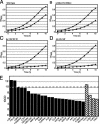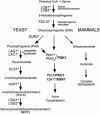Yeast genome-wide drug-induced haploinsufficiency screen to determine drug mode of action
- PMID: 15070751
- PMCID: PMC384780
- DOI: 10.1073/pnas.0307122101
Yeast genome-wide drug-induced haploinsufficiency screen to determine drug mode of action
Abstract
Methods to systematically test drugs against all possible proteins in a cell are needed to identify the targets underlying their therapeutic action and unwanted effects. Here, we show that a genome-wide drug-induced haploinsufficiency screen by using yeast can reveal drug mode of action in yeast and can be used to predict drug mode of action in human cells. We demonstrate that dihydromotuporamine C, a compound in preclinical development that inhibits angiogenesis and metastasis by an unknown mechanism, targets sphingolipid metabolism. The systematic, unbiased and genome-wide nature of this technique makes it attractive as a general approach to identify cellular pathways affected by drugs.
Figures




References
-
- Mayer, T. U., Kapoor, T. M., Haggarty, S. J., King, R. W., Schreiber, S. L. & Mitchison, T. J. (1999) Science 286, 971–974. - PubMed
-
- Roskelley, C. D., Williams, D. E., McHardy, L. M., Leong, K. G., Troussard, A., Karsan, A., Andersen, R. J., Dedhar, S. & Roberge, M. (2001) Cancer Res. 61, 6788–6794. - PubMed
-
- Lokey, R. S. (2003) Curr. Opin. Chem. Biol. 7, 91–96. - PubMed
-
- Hughes, T. R. (2002) Funct. Integr. Genomics 2, 199–211. - PubMed
-
- Parsons, A. B., Geyer, R., Hughes, T. R. & Boone, C. (2003) Prog. Cell Cycle Res. 5, 159–166. - PubMed
Publication types
MeSH terms
Substances
Grants and funding
LinkOut - more resources
Full Text Sources
Other Literature Sources
Molecular Biology Databases

